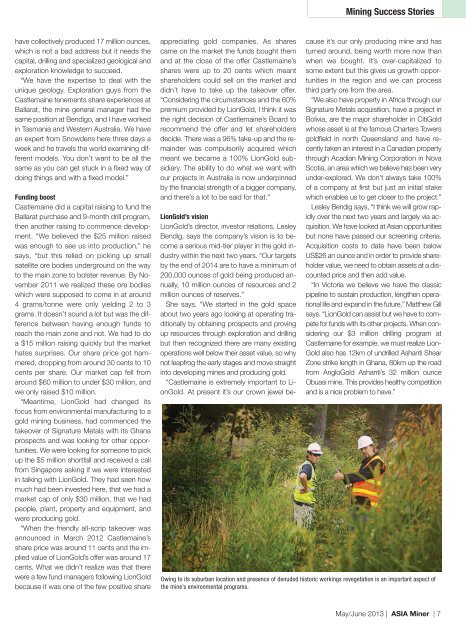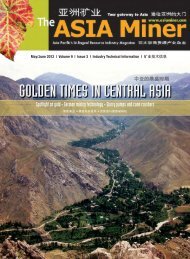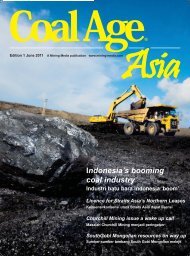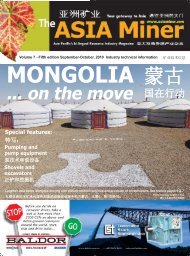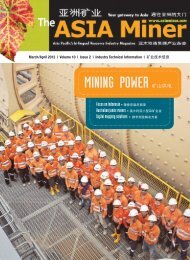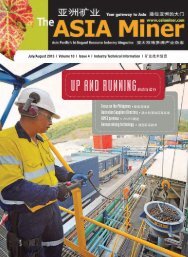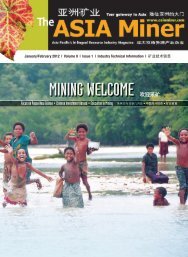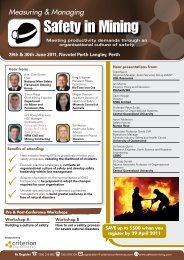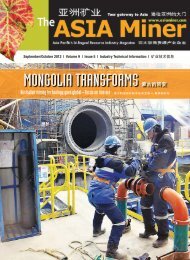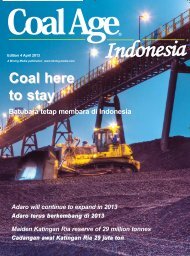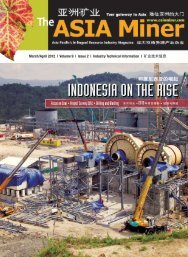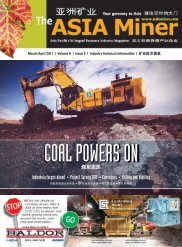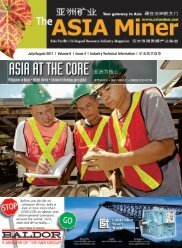May/June 2013 - The ASIA Miner
May/June 2013 - The ASIA Miner
May/June 2013 - The ASIA Miner
You also want an ePaper? Increase the reach of your titles
YUMPU automatically turns print PDFs into web optimized ePapers that Google loves.
Mining Success Stories<br />
have collectively produced 17 million ounces,<br />
which is not a bad address but it needs the<br />
capital, drilling and specialized geological and<br />
exploration knowledge to succeed.<br />
“We have the expertise to deal with the<br />
unique geology. Exploration guys from the<br />
Castlemaine tenements share experiences at<br />
Ballarat, the mine general manager had the<br />
same position at Bendigo, and I have worked<br />
in Tasmania and Western Australia. We have<br />
an expert from Snowdens here three days a<br />
week and he travels the world examining different<br />
models. You don’t want to be all the<br />
same as you can get stuck in a fixed way of<br />
doing things and with a fixed model.”<br />
Funding boost<br />
Castlemaine did a capital raising to fund the<br />
Ballarat purchase and 9-month drill program,<br />
then another raising to commence development.<br />
“We believed the $25 million raised<br />
was enough to see us into production,” he<br />
says, “but this relied on picking up small<br />
satellite ore bodies underground on the way<br />
to the main zone to bolster revenue. By November<br />
2011 we realized these ore bodies<br />
which were supposed to come in at around<br />
4 grams/tonne were only yielding 2 to 3<br />
grams. It doesn’t sound a lot but was the difference<br />
between having enough funds to<br />
reach the main zone and not. We had to do<br />
a $15 million raising quickly but the market<br />
hates surprises. Our share price got hammered,<br />
dropping from around 30 cents to 10<br />
cents per share. Our market cap fell from<br />
around $60 million to under $30 million, and<br />
we only raised $10 million.<br />
“Meantime, LionGold had changed its<br />
focus from environmental manufacturing to a<br />
gold mining business, had commenced the<br />
takeover of Signature Metals with its Ghana<br />
prospects and was looking for other opportunities.<br />
We were looking for someone to pick<br />
up the $5 million shortfall and received a call<br />
from Singapore asking if we were interested<br />
in talking with LionGold. <strong>The</strong>y had seen how<br />
much had been invested here, that we had a<br />
market cap of only $30 million, that we had<br />
people, plant, property and equipment, and<br />
were producing gold.<br />
“When the friendly all-scrip takeover was<br />
announced in March 2012 Castlemaine’s<br />
share price was around 11 cents and the implied<br />
value of LionGold’s offer was around 17<br />
cents. What we didn’t realize was that there<br />
were a few fund managers following LionGold<br />
because it was one of the few positive share<br />
appreciating gold companies. As shares<br />
came on the market the funds bought them<br />
and at the close of the offer Castlemaine’s<br />
shares were up to 20 cents which meant<br />
shareholders could sell on the market and<br />
didn’t have to take up the takeover offer.<br />
“Considering the circumstances and the 60%<br />
premium provided by LionGold, I think it was<br />
the right decision of Castlemaine’s Board to<br />
recommend the offer and let shareholders<br />
decide. <strong>The</strong>re was a 96% take-up and the remainder<br />
was compulsorily acquired which<br />
meant we became a 100% LionGold subsidiary.<br />
<strong>The</strong> ability to do what we want with<br />
our projects in Australia is now underpinned<br />
by the financial strength of a bigger company,<br />
and there’s a lot to be said for that.”<br />
LionGold’s vision<br />
LionGold’s director, investor relations, Lesley<br />
Bendig, says the company’s vision is to become<br />
a serious mid-tier player in the gold industry<br />
within the next two years. “Our targets<br />
by the end of 2014 are to have a minimum of<br />
200,000 ounces of gold being produced annually,<br />
10 million ounces of resources and 2<br />
million ounces of reserves.”<br />
She says, “We started in the gold space<br />
about two years ago looking at operating traditionally<br />
by obtaining prospects and proving<br />
up resources through exploration and drilling<br />
but then recognized there are many existing<br />
operations well below their asset value, so why<br />
not leapfrog the early stages and move straight<br />
into developing mines and producing gold.<br />
“Castlemaine is extremely important to LionGold.<br />
At present it’s our crown jewel because<br />
it’s our only producing mine and has<br />
turned around, being worth more now than<br />
when we bought. It’s over-capitalized to<br />
some extent but this gives us growth opportunities<br />
in the region and we can process<br />
third party ore from the area.<br />
“We also have property in Africa through our<br />
Signature Metals acquisition, have a project in<br />
Bolivia, are the major shareholder in CitiGold<br />
whose asset is at the famous Charters Towers<br />
goldfield in north Queensland and have recently<br />
taken an interest in a Canadian property<br />
through Acadian Mining Corporation in Nova<br />
Scotia, an area which we believe has been very<br />
under-explored. We don’t always take 100%<br />
of a company at first but just an initial stake<br />
which enables us to get closer to the project.”<br />
Lesley Bendig says, “I think we will grow rapidly<br />
over the next two years and largely via acquisition.<br />
We have looked at Asian opportunities<br />
but none have passed our screening criteria.<br />
Acquisition costs to date have been below<br />
US$26 an ounce and in order to provide shareholder<br />
value, we need to obtain assets at a discounted<br />
price and then add value.<br />
“In Victoria we believe we have the classic<br />
pipeline to sustain production, lengthen operational<br />
life and expand in the future,” Matthew Gill<br />
says. “LionGold can assist but we have to compete<br />
for funds with its other projects. When considering<br />
our $3 million drilling program at<br />
Castlemaine for example, we must realize Lion-<br />
Gold also has 12km of undrilled Ashanti Shear<br />
Zone strike length in Ghana, 80km up the road<br />
from AngloGold Ashanti’s 32 million ounce<br />
Obuasi mine. This provides healthy competition<br />
and is a nice problem to have.”<br />
Owing to its suburban location and presence of denuded historic workings revegetation is an important aspect of<br />
the mine’s environmental programs.<br />
<strong>May</strong>/<strong>June</strong> <strong>2013</strong> | <strong>ASIA</strong> <strong>Miner</strong> | 7


